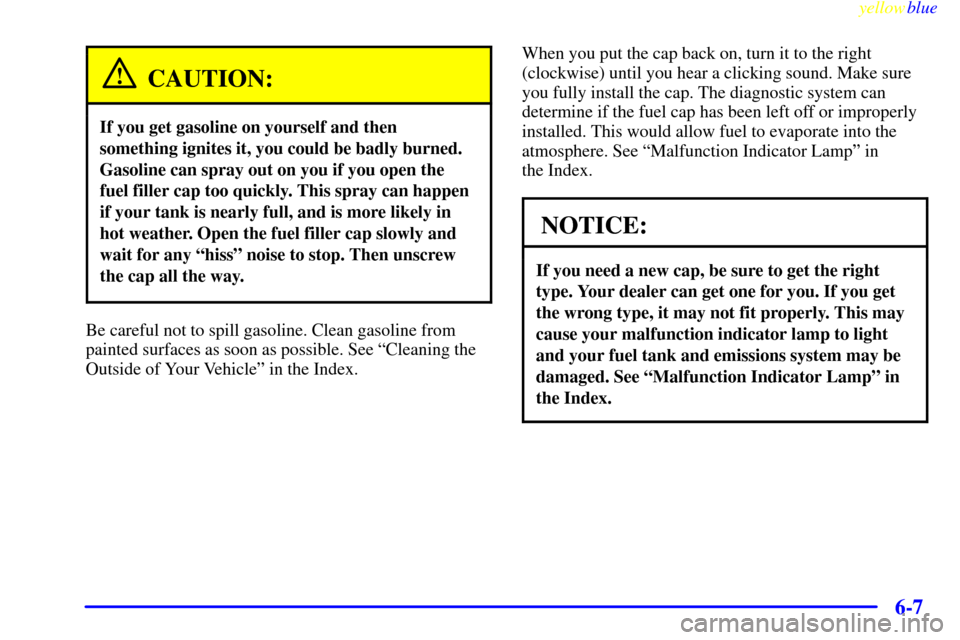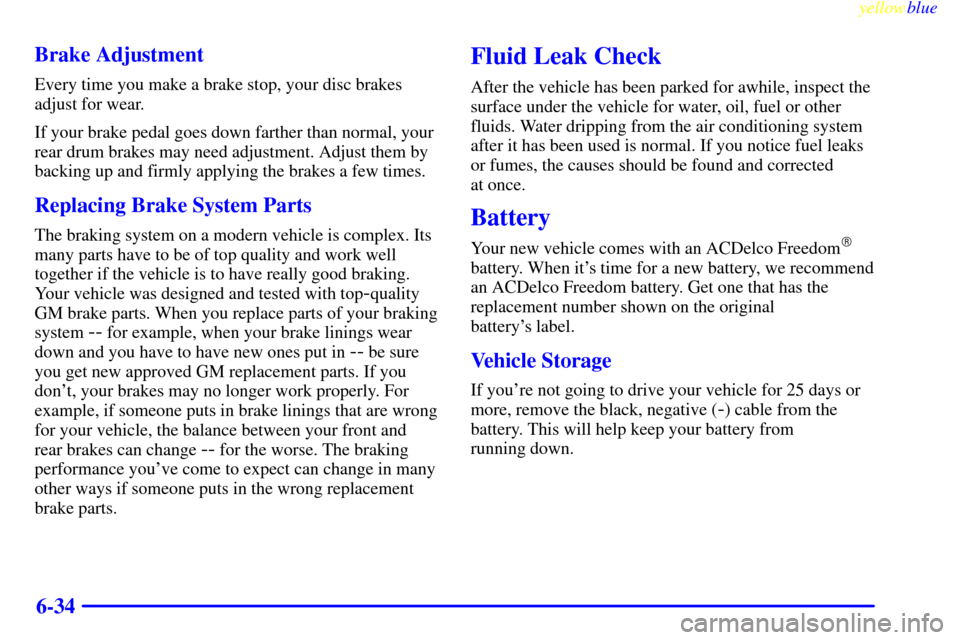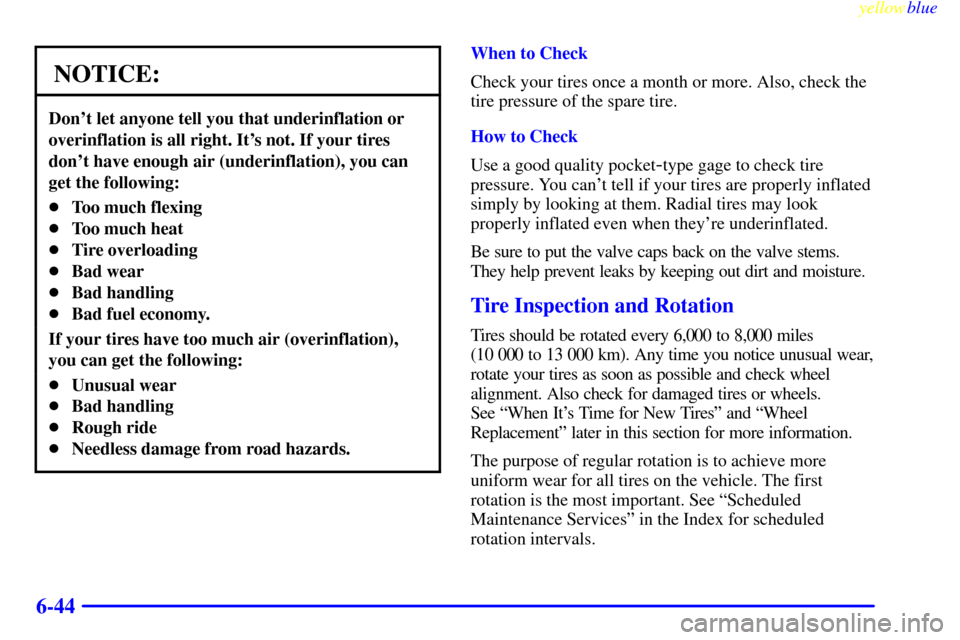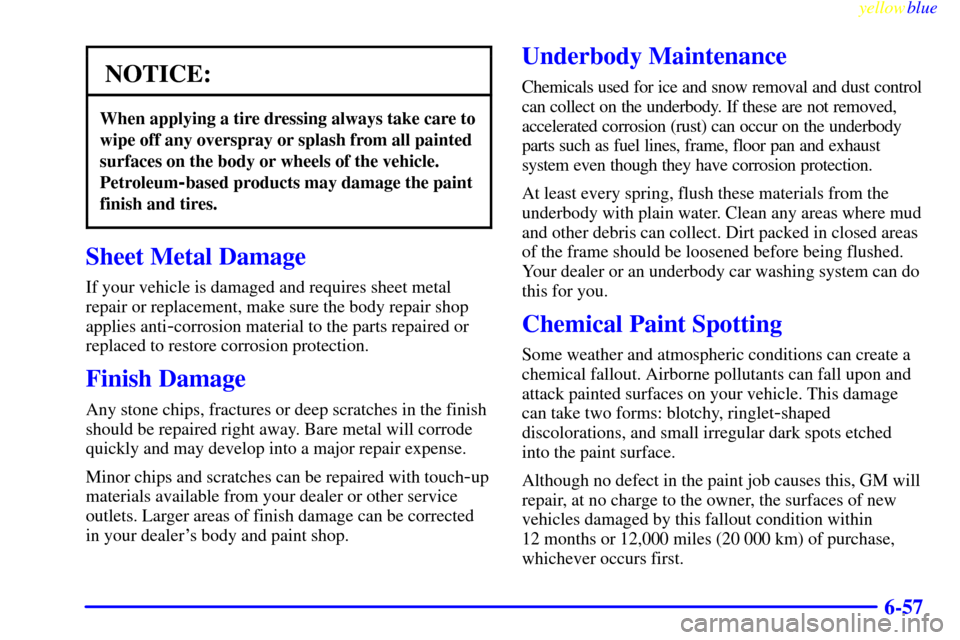Page 287 of 424

yellowblue
6-7
CAUTION:
If you get gasoline on yourself and then
something ignites it, you could be badly burned.
Gasoline can spray out on you if you open the
fuel filler cap too quickly. This spray can happen
if your tank is nearly full, and is more likely in
hot weather. Open the fuel filler cap slowly and
wait for any ªhissº noise to stop. Then unscrew
the cap all the way.
Be careful not to spill gasoline. Clean gasoline from
painted surfaces as soon as possible. See ªCleaning the
Outside of Your Vehicleº in the Index.When you put the cap back on, turn it to the right
(clockwise) until you hear a clicking sound. Make sure
you fully install the cap. The diagnostic system can
determine if the fuel cap has been left off or improperly
installed. This would allow fuel to evaporate into the
atmosphere. See ªMalfunction Indicator Lampº in
the Index.
NOTICE:
If you need a new cap, be sure to get the right
type. Your dealer can get one for you. If you get
the wrong type, it may not fit properly. This may
cause your malfunction indicator lamp to light
and your fuel tank and emissions system may be
damaged. See ªMalfunction Indicator Lampº in
the Index.
Page 288 of 424

yellowblue
6-8
Filling a Portable Fuel Container
CAUTION:
Never fill a portable fuel container while it is in
your vehicle. Static electricity discharge from the
container can ignite the gasoline vapor. You can
be badly burned and your vehicle damaged if this
occurs. To help avoid injury to you and others:
�Dispense gasoline only into approved
containers.
�Do not fill a container while it is inside a
vehicle, in a vehicle's trunk, pickup bed or
on any surface other than the ground.
�Bring the fill nozzle in contact with the
inside of the fill opening before operating
the nozzle. Contact should be maintained
until the filling is complete.
�Don't smoke while pumping gasoline.
Checking Things Under the Hood
CAUTION:
If your vehicle has air conditioning, the auxiliary
engine fan under the hood can start up and
injure you even when the engine is not running.
Keep hands, clothing and tools away from any
underhood electric fan.
CAUTION:
Things that burn can get on hot engine parts and
start a fire. These include liquids like gasoline or
diesel fuel, oil, coolant, brake fluid, windshield
washer and other fluids, and plastic or rubber. You
or others could be burned. Be careful not to drop
or spill things that will burn onto a hot engine.
Page 292 of 424
yellowblue
6-12
Engine Oil (Gasoline Engine)
If your vehicle has a diesel engine, see ªEngine Oil
(Diesel Engine)º in the Diesel Engine Supplement.
It's a good idea to check your engine oil every time you
get fuel. In order to get an accurate reading, the oil must
be warm and the vehicle must be on level ground.
The engine oil dipstick has a yellow ring handle and is
located on the passenger's side of the engine.
Turn off the engine and give the oil a few minutes to
drain back into the oil pan. If you don't, the oil dipstick
might not show the actual level.
Page 314 of 424

yellowblue
6-34 Brake Adjustment
Every time you make a brake stop, your disc brakes
adjust for wear.
If your brake pedal goes down farther than normal, your
rear drum brakes may need adjustment. Adjust them by
backing up and firmly applying the brakes a few times.
Replacing Brake System Parts
The braking system on a modern vehicle is complex. Its
many parts have to be of top quality and work well
together if the vehicle is to have really good braking.
Your vehicle was designed and tested with top
-quality
GM brake parts. When you replace parts of your braking
system
-- for example, when your brake linings wear
down and you have to have new ones put in
-- be sure
you get new approved GM replacement parts. If you
don't, your brakes may no longer work properly. For
example, if someone puts in brake linings that are wrong
for your vehicle, the balance between your front and
rear brakes can change
-- for the worse. The braking
performance you've come to expect can change in many
other ways if someone puts in the wrong replacement
brake parts.
Fluid Leak Check
After the vehicle has been parked for awhile, inspect the
surface under the vehicle for water, oil, fuel or other
fluids. Water dripping from the air conditioning system
after it has been used is normal. If you notice fuel leaks
or fumes, the causes should be found and corrected
at once.
Battery
Your new vehicle comes with an ACDelco Freedom�
battery. When it's time for a new battery, we recommend
an ACDelco Freedom battery. Get one that has the
replacement number shown on the original
battery's label.
Vehicle Storage
If you're not going to drive your vehicle for 25 days or
more, remove the black, negative (
-) cable from the
battery. This will help keep your battery from
running down.
Page 324 of 424

yellowblue
6-44
NOTICE:
Don't let anyone tell you that underinflation or
overinflation is all right. It's not. If your tires
don't have enough air (underinflation), you can
get the following:
�Too much flexing
�Too much heat
�Tire overloading
�Bad wear
�Bad handling
�Bad fuel economy.
If your tires have too much air (overinflation),
you can get the following:
�Unusual wear
�Bad handling
�Rough ride
�Needless damage from road hazards.
When to Check
Check your tires once a month or more. Also, check the
tire pressure of the spare tire.
How to Check
Use a good quality pocket
-type gage to check tire
pressure. You can't tell if your tires are properly inflated
simply by looking at them. Radial tires may look
properly inflated even when they're underinflated.
Be sure to put the valve caps back on the valve stems.
They help prevent leaks by keeping out dirt and moisture.
Tire Inspection and Rotation
Tires should be rotated every 6,000 to 8,000 miles
(10 000 to 13 000 km). Any time you notice unusual wear,
rotate your tires as soon as possible and check wheel
alignment. Also check for damaged tires or wheels.
See ªWhen It's Time for New Tiresº and ªWheel
Replacementº later in this section for more information.
The purpose of regular rotation is to achieve more
uniform wear for all tires on the vehicle. The first
rotation is the most important. See ªScheduled
Maintenance Servicesº in the Index for scheduled
rotation intervals.
Page 337 of 424

yellowblue
6-57
NOTICE:
When applying a tire dressing always take care to
wipe off any overspray or splash from all painted
surfaces on the body or wheels of the vehicle.
Petroleum
-based products may damage the paint
finish and tires.
Sheet Metal Damage
If your vehicle is damaged and requires sheet metal
repair or replacement, make sure the body repair shop
applies anti
-corrosion material to the parts repaired or
replaced to restore corrosion protection.
Finish Damage
Any stone chips, fractures or deep scratches in the finish
should be repaired right away. Bare metal will corrode
quickly and may develop into a major repair expense.
Minor chips and scratches can be repaired with touch
-up
materials available from your dealer or other service
outlets. Larger areas of finish damage can be corrected
in your dealer's body and paint shop.
Underbody Maintenance
Chemicals used for ice and snow removal and dust control
can collect on the underbody. If these are not removed,
accelerated corrosion (rust) can occur on the underbody
parts such as fuel lines, frame, floor pan and exhaust
system even though they have corrosion protection.
At least every spring, flush these materials from the
underbody with plain water. Clean any areas where mud
and other debris can collect. Dirt packed in closed areas
of the frame should be loosened before being flushed.
Your dealer or an underbody car washing system can do
this for you.
Chemical Paint Spotting
Some weather and atmospheric conditions can create a
chemical fallout. Airborne pollutants can fall upon and
attack painted surfaces on your vehicle. This damage
can take two forms: blotchy, ringlet
-shaped
discolorations, and small irregular dark spots etched
into the paint surface.
Although no defect in the paint job causes this, GM will
repair, at no charge to the owner, the surfaces of new
vehicles damaged by this fallout condition within
12 months or 12,000 miles (20 000 km) of purchase,
whichever occurs first.
Page 344 of 424
yellowblue
6-64
Name Circuits Protected
ECM
-B Fuel Pump, PCM/VCM
RR DEFOG Rear Window Defogger
(If Equipped)
IGN
-E Auxiliary Fan Relay Coil, A/C
Compressor Relay, Hot Fuel Module
FUEL SOL Fuel Solenoid (Diesel Engine)
GLOW PLUG Glow plugs (Diesel Engine)
HORN Horn, Underhood LampsName Circuits Protected
AUX FAN Auxiliary Fan
ECM
-1 Injectors, PCM/VCM
HTD ST
-FR Heated Front Seats
A/C Air Conditioning
HTD MIR Heated Outside Mirrors (If Equipped)
ENG
-1 Ignition Switch, EGR, Canister
Purge, EVRV Idle Coast Solenoid,
Heated O
2, Fuel Heater
(Diesel Engine), Water Sensor
(Diesel Engine)
HTD ST
-RR Not Used
LIGHTING Headlamp and Panel Dimmer
Switch, Fog and Courtesy Fuses
BATT Battery, Fuse Block Busbar
IGN
-A Ignition Switch
IGN
-B Ignition Switch
ABS Anti
-Lock Brake Module
BLOWER Hi Blower and Rear Blower Relays
STOP/HAZ Stoplamps
HEATED SEATS Heated Seats (If Equipped)
Page 347 of 424
yellowblue
6-67
Capacities and Specifications
Please refer to ªRecommended Fluids and Lubricantsº in the Index for more information.
Engine Identification -- Gasoline Engines
EngineªVORTECº 5700 ªVORTECº 7400
Type V8 V8
RPO Code L31 L29
VIN Code R J
Fuel System SFI* SFI*
*Sequential Fuel Injection
Wheels and Tires
MODEL DESCRIPTION TORQUE
C 1500 5 bolts (14 mm)
140 lb
-ft (190 N´m)
K 1500, C
-K 25006 bolts (14 mm)
140 lb-ft (190 N´m)
C
-K 25008 bolts (14 mm)
140 lb-ft (190 N´m)
Tire Pressure See the Certification/Tire label
on the rear edge of the driver's
door or the incomplete vehicle
document in the cab.